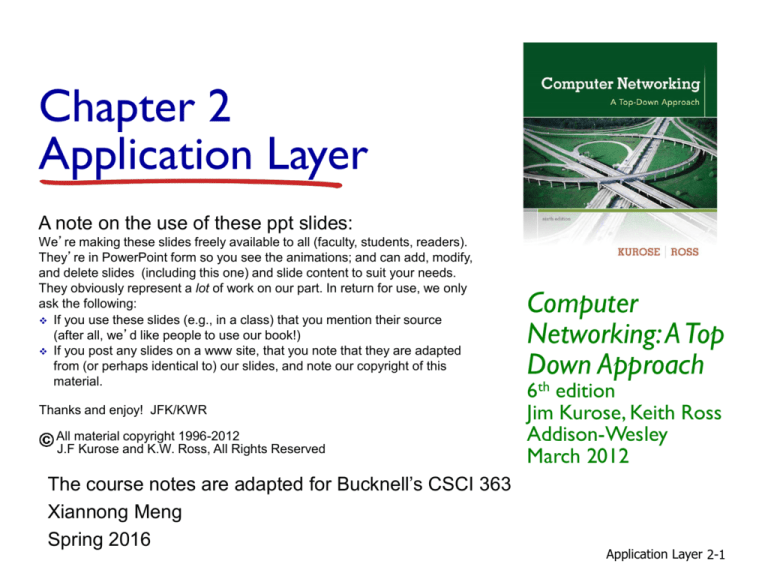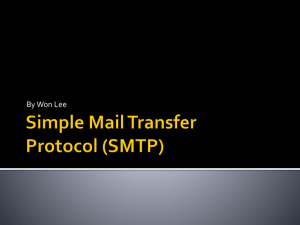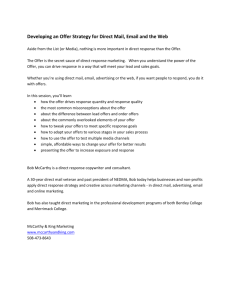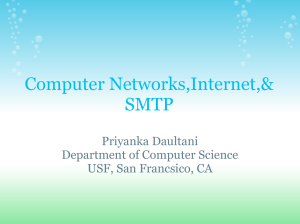
Chapter 2
Application Layer
A note on the use of these ppt slides:
We’re making these slides freely available to all (faculty, students, readers).
They’re in PowerPoint form so you see the animations; and can add, modify,
and delete slides (including this one) and slide content to suit your needs.
They obviously represent a lot of work on our part. In return for use, we only
ask the following:
If you use these slides (e.g., in a class) that you mention their source
(after all, we’d like people to use our book!)
If you post any slides on a www site, that you note that they are adapted
from (or perhaps identical to) our slides, and note our copyright of this
material.
Thanks and enjoy! JFK/KWR
All material copyright 1996-2012
J.F Kurose and K.W. Ross, All Rights Reserved
The course notes are adapted for Bucknell’s CSCI 363
Xiannong Meng
Spring 2016
Computer
Networking: A Top
Down Approach
6th edition
Jim Kurose, Keith Ross
Addison-Wesley
March 2012
Application Layer 2-1
Chapter 2: outline
2.1 principles of network
applications
app architectures
app requirements
2.6 P2P applications
2.7 socket programming
with UDP and TCP
2.2 Web and HTTP
2.3 FTP
2.4 electronic mail
SMTP, POP3, IMAP
2.5 DNS
Application Layer 2-2
FTP: the file transfer protocol
FTP
user
interface
user
at host
file transfer
FTP
client
FTP
server
local file
system
remote file
system
transfer file to/from remote host
client/server model
client: side that initiates transfer (either to/from remote)
server: remote host
ftp: RFC 959
ftp server: port 21, sftp server: port 115
Application Layer 2-3
FTP: separate control, data connections
FTP client contacts FTP server
at port 21, using TCP
client authorized over control
connection
client browses remote
directory, sends commands
over control connection
when server receives file
transfer command, server
opens 2nd TCP data
connection (for file) to client
TCP control connection,
server port 21
FTP
client
TCP data connection,
server port 20
FTP
server
after transferring the file,
server closes data
connection
control connection: “out of
band”
FTP server maintains
“state”: current directory,
earlier authentication
Application Layer 2-4
FTP commands, responses
sample commands:
sent as ASCII text over
control channel
USER username
PASS password
LIST return list of file in
current directory
RETR filename
retrieves (gets) file
STOR filename stores
(puts) file onto remote
host
sample return codes
status code and phrase (as
in HTTP)
331 Username OK,
password required
125 data
connection
already open;
transfer starting
425 Can’t open
data connection
452 Error writing
file
Application Layer 2-5
Chapter 2: outline
2.1 principles of network
applications
app architectures
app requirements
2.6 P2P applications
2.7 socket programming
with UDP and TCP
2.2 Web and HTTP
2.3 FTP
2.4 electronic mail
SMTP, POP3, IMAP
2.5 DNS
Application Layer 2-6
Electronic mail
outgoing
message queue
Three major components:
user agents
mail servers
simple mail transfer protocol:
SMTP
user mailbox
user
agent
mail
server
user
agent
SMTP
User Agent
a.k.a. “mail reader”
composing, editing, reading mail
messages
e.g., Gmail, Outlook,
Thunderbird, iPhone mail client
(app)
outgoing, incoming messages
stored on server
mail
server
user
agent
SMTP
SMTP
mail
server
user
agent
user
agent
user
agent
Application Layer 2-7
Electronic mail: mail servers
mail servers:
mailbox contains incoming
messages for user
message queue of outgoing
(to be sent) mail messages
SMTP protocol between
mail servers to send email
messages
client: sending mail
server
“server”: receiving mail
server
user
agent
mail
server
user
agent
SMTP
mail
server
user
agent
SMTP
SMTP
mail
server
user
agent
user
agent
user
agent
Application Layer 2-8
Finding out about mail server
At the Linux prompt, try
dig mail.bucknell.edu mx
The returned information contains mail server
exchanger record (‘mx’ option in the command)
Try another one
dig yahoo.com mx +noall +answer
The output is a quinte-tuple of the form
name ttl class type type-specific-data
E.g., yahoo.com. 393 IN MX 1 mta6.am0.yahoodns.net
name: yahoo.com, ttl: 393 min, class: IN, type MX, …
Details of DNS will come next couple lectures.
Application Layer 2-9
Electronic Mail: SMTP [RFC 2821]
uses TCP to reliably transfer email message from
client to server, port 25
direct transfer: sending server to receiving
server
three phases of transfer
handshaking (greeting)
transfer of messages
closure
command/response interaction (like HTTP, FTP)
commands: ASCII text
response: status code and phrase
messages must be in 7-bit ASCI
Application Layer 2-10
Scenario: Alice sends message to Bob
4) SMTP client sends Alice’s
message over the TCP
connection
5) Bob’s mail server places the
message in Bob’s mailbox
6) Bob invokes his user agent
to read message
1) Alice uses UA to compose
message “to”
bob@someschool.edu
2) Alice’s UA sends message
to her mail server; message
placed in message queue
3) client side of SMTP opens
TCP connection with Bob’s
mail server
1 user
agent
2
mail
server
3
Alice’s mail server
user
agent
mail
server
4
6
5
Bob’s mail server
Application Layer 2-11
Sample SMTP interaction
S:
C:
S:
C:
S:
C:
S:
C:
S:
C:
C:
C:
S:
C:
S:
220 hamburger.edu
HELO crepes.fr
250 Hello crepes.fr, pleased to meet you
MAIL FROM: <alice@crepes.fr>
250 alice@crepes.fr... Sender ok
RCPT TO: <bob@hamburger.edu>
250 bob@hamburger.edu ... Recipient ok
DATA
354 Enter mail, end with "." on a line by itself
Do you like ketchup?
How about pickles?
.
250 Message accepted for delivery
QUIT
221 hamburger.edu closing connection
Application Layer 2-12
Try SMTP interaction for yourself:
telnet servername 25
see 220 reply from server
enter HELO, MAIL FROM, RCPT TO, DATA, QUIT
commands
above lets you send email without using email client (reader)
Application Layer 2-13
SMTP: final words
SMTP uses persistent
connections
SMTP requires message
(header & body) to be in
7-bit ASCII
SMTP server uses
CRLF.CRLF to
determine end of message
comparison with HTTP:
HTTP: pull
SMTP: push
both have ASCII
command/response
interaction, status codes
HTTP: each object
encapsulated in its own
response msg
SMTP: multiple objects
sent in multipart msg
Application Layer 2-14
Mail message format
SMTP: protocol for
exchanging email msgs
RFC 822: standard for text
message format:
header lines, e.g.,
To:
From:
Subject:
header
blank
line
body
different from SMTP MAIL
FROM, RCPT TO:
commands!
Body: the “message”
ASCII characters only
Application Layer 2-15
Mail access protocols
user
agent
SMTP
SMTP
mail access
protocol
user
agent
(e.g., POP,
IMAP)
sender’s mail
server
receiver’s mail
server
SMTP: delivery/storage to receiver’s server
mail access protocol: retrieval from server
POP: Post Office Protocol [RFC 1939]: authorization,
download
IMAP: Internet Mail Access Protocol [RFC 1730]: more
features, including manipulation of stored msgs on
server
HTTP: gmail, Hotmail, Yahoo! Mail, etc.
Application Layer 2-16






